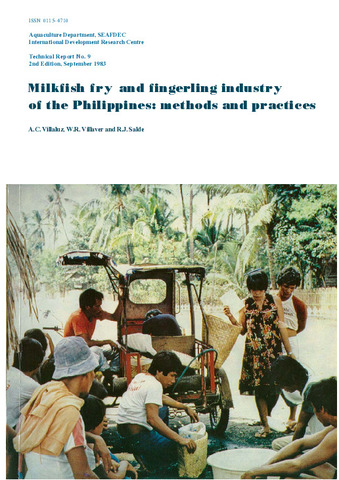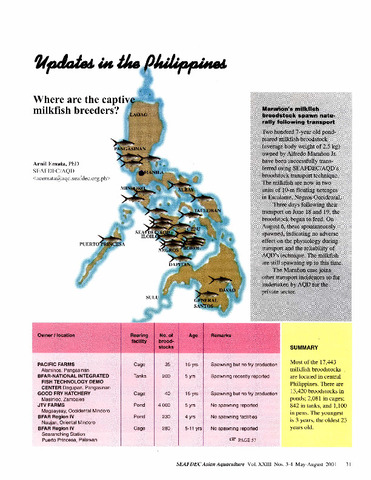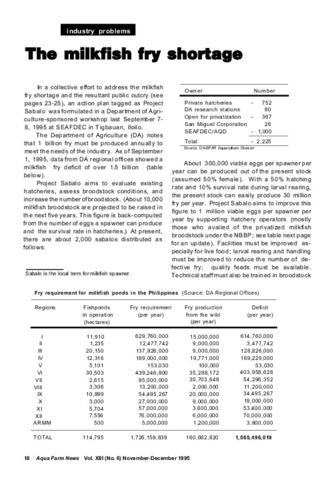Milkfish fry and fingerling industry of the Philippines: methods and practices
Share
Abstract
Milkfish fry catch from Philippine waters can still be increased. Intensified collections in traditional fry grounds and exploitation of new areas may lead to a reduction of adult stock and the possible collapse of the milkfish fry fishery. The implementation of rational conservation and management measures are of immediate concern not only to increase the productivity and number of fry grounds but also to conserve this important aquatic resource.
The present methods of catching milkfish fry involve fry filtration by mobile or stationary devices. The design, construction, area and time of operation of the gears are primarily dictated by the bottom topography of the fry grounds, wind direction, local current patterns and tidal fluctuations.
Catching, handling, storage and transport activities expose the fish to undue stress which contribute to poor survival. The simple method of lowering the salinity of the water medium considerably reduces mortality.
High mortality in nursery ponds has aggravated the seed shortage problem of the milkfish industry. The development of an efficient mass-production technology in rearing milkfish fry to fingerlings and in stunting fingerlings for longer periods could offer the solution not only in meeting the requirements for milkfish seed but also provide part of the fry requirements of other countries in the region.
Description
2nd Edition.
Suggested Citation
Villaluz, A. C., Villaver, W. R., & Salde, R. J. (1983). Milkfish fry and fingerling industry of the Philippines: methods and practices. (Technical Report No. 9) (2nd ed.). Tigbauan, Iloilo, Philippines: Aquaculture Department, Southeast Asian Fisheries Development Center.
Subject
Taxonomic term
Collections
Related items
Showing items related by title, author, creator and subject.
-
Milkfish fry collection and handling
Villaluz, A.C. (Food and Agriculture Organization of the United Nations, South Pacific Aquaculture Development Project, 1990)Milkfish fry can be collected in almost all the coastal waters of the tropical Indo-Pacific region. The fry season occurs at different times of the year in various sections of the species' geographical range. The season ... -
Updates in the Philippines: Where are the captive milkfish breeders?
Emata, Arnil C. (Aquaculture Department, Southeast Asian Fisheries Development Center, 2001)A map is provided showing the location of milkfish rearing facilities in the Philippines. Most of the 17,443 milkfish broodstocks are located in central Philippines. A table shows details as to the rearing facility (cage, ... -
The milkfish fry shortage
Southeast Asian Fisheries Development Center, Aquaculture Department (Aquaculture Department, Southeast Asian Fisheries Development Center, 1995)The article presents the Philippines, Department of Agriculture Project Sabalo which aims to address the milkfish fry shortage of the country. The project also aims to evaluate existing hatcheries, assess broodstock ...






